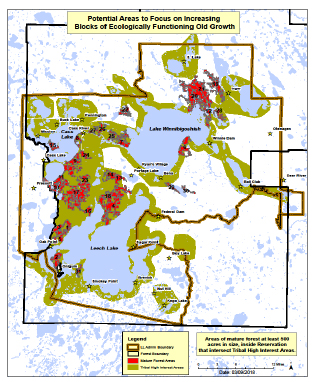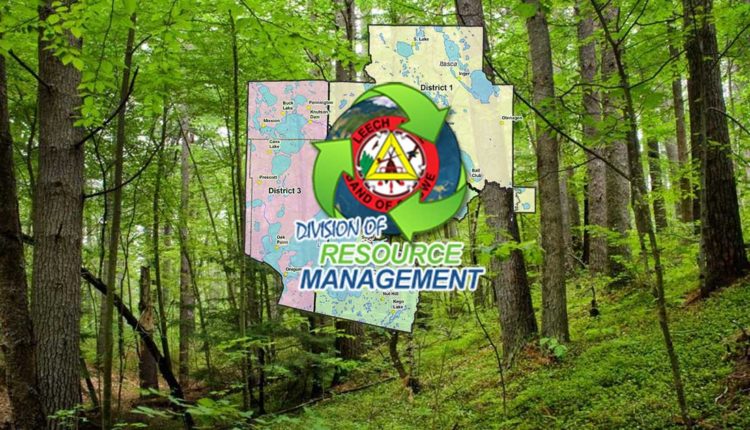Are you satisfied with the way our forests are being managed? Let your voice be heard. The Leech Lake Band of Ojibwe Division of Resource Management has been directed to begin a rulemaking process for managing the forest and wants your input.
For years the Chippewa National Forest (CNF) and Leech Lake Band of Ojibwe (LLBO) have been meeting to discuss management of CNF lands to ensure the management undertaken protects the Reserved Rights and the cultural practices of the Leech Lake Band of Ojibwe that are tied to the land and availability of resources. LLBO has expressed a desire to return forest conditions, to the extent possible, to pre-European settlement conditions and Range of Natural Variability, which is the balance of old and young trees that would occur naturally. Certainly, we realize this is not feasible overnight, however by setting current forest management on a trajectory that addresses holistic ecological management, an expression of this desire can be achieved.
A step to address this broader vision was to formulate some basic management priorities. These guiding principles became the Leech Lake Band of Ojibwe–Desired Vegetative Conditions (DVC’s). These 8 DVCs are designed to be included in the purpose and need section of documents where decisions are made that manage the forest. While the DVCs are founded through work with the CNF they are applicable across all land managers who have forested land within Leech Lake Reservation. While agencies may hold land within the boundaries, the property rights of resources on those lands rests with the Leech Lake Band as established in the 1971 Herbst case. Inclusion of the DVC’s ensures that projects within the Leech Lake Reservation (LLR) are fulfilling the Trust Responsibility the Forest Service is tasked to uphold and protects the resources that Leech Lake Band retains property rights of. The DVC’s focus on ecological goals and ensuring that cultural and environmental justice is prioritized on LLR.

Public Comment period is from August 15th through November 12th and will be accepted at the Leech Lake Division of Resource Management. There will be community meetings held in each district in early October to present the proposed rule and accept comments. Community meeting information will be released when dates are finalized. Questions and comments can be directed to Ben Benoit, Environmental Director at 335-7421 or [email protected]. Additional information available on the DRM website located http://www.llojibwe.org/drm/index.html
Desired Vegetative Conditions
LLDVC-1 Increase blocks of ecologically functioning old growth stands
LLDVC-2 Protection of Scenic Corridors (Road Corridors, rivers, lakes, Old Growth Rec. sites)
LLDVC-3 Impacts to TES/TCP’s are impacts to Tribes cultural Identity
LLDVC-4 Maintain and Protect Diverse Hardwoods stands
LLDVC-5 Protecting the cultural integrity of the LLBO
LLDVC-6 Aspen Initiative – reduce aspen promote other species
LLDVC-7 Restore ecologically functioning conifer systems
LLDVC-8 Implementation must correspond with approved action
Four DVCs focus on ecological management of the forest. The intent of the ecological DVCs, when tied together, is to achieve forest conditions more reflective of historical range of natural variation. To achieve this and allow for ecological old-growth characteristics, the gradation of stand ages needs to occur from age zero to their respective ecological rotation ages, based on, for example, historic disturbance regimes, to truly allow this function to occur.
LLBO proposes a shift in management towards ecological Range of Natural Variation (RNV), using pre-European settlement vegetation and Native Plant Communities analyses as a base, and adjusting as necessary. Traditional Ecological Knowledge (TEK) follows in-line with holistic management; a realization of the broad expanse of variation throughout stands as a whole provide the framework of the historical conditions the Leech Lake Band of Ojibwe Tribal Members call home.
Aspen (DVC6)— Aspen (Popple) is a component in many local native plant communities but is currently over represented on the landscape. This is an early successional species meaning that aspen comes first and as they die off and let light through the canopy other later successional species get the opportunity to grow up in the gaps that are created. Through time, the aspen stand would “succeed” into a stand with a different dominant tree makeup. Current forest practice is to harvest all the aspen and let it regenerate, leaving it in this “early successional state” rather than let the forest grow into something else. This practice is common across MN due to the timber value of aspen and LLR is no exception.
This overabundance of aspen lends itself towards conversion to other species. Some of this conversion can be allowing a stand to naturally succeed to other species (with reforestation assistance in the understory where a seed source is depleted). Some of this work may require harvest and conversion to achieve an appropriate percentage of other species that have been displaced.
Hardwoods (DVC4)— In general most hardwood stands are later successional and require protection so the process isn’t restarted. It is our intention to provide guidance for management actions that would promote range of natural variation within these ecological communities with a priority given to maintain in an older age class condition. Some hardwood stands are best maintained by allowing them to naturally maintain themselves. Other stands will require on-going work to achieve old-growth characteristics and a natural range of variation.
 Old Growth Connectivity (DV1) –LLBO would like to begin building blocks of ecologically mature forest and, through management, tie these blocks together. Our meetings to date have identified areas with CNF ownership which to increase blocks of functioning old growth that could serve as a starting point to achieve this DVC and move toward a more natural range of variation and larger blocks of mature forest. While these blocks may not currently be considered “old growth” from an ecological sense, they could be in time and be the foundation to build on.
Old Growth Connectivity (DV1) –LLBO would like to begin building blocks of ecologically mature forest and, through management, tie these blocks together. Our meetings to date have identified areas with CNF ownership which to increase blocks of functioning old growth that could serve as a starting point to achieve this DVC and move toward a more natural range of variation and larger blocks of mature forest. While these blocks may not currently be considered “old growth” from an ecological sense, they could be in time and be the foundation to build on.
Conifer (DVC7)—Suitable percentages of conifers are missing from many native plant communities or, in cases of plantation origin stands, conifers are too dense and require thinning at earlier ages to allow them to become the large trees that were historically here. This DVC is focused on 2 parts. The first is ecological restoration focused on 20-40 year-old pine plantations. After harvest, pine plantations are planted at tree densities so high that trees are unable to maintain suitable canopy because they are crowding each other. As they grow into the 20-40 age range this results in a Q-tip looking tree rather than the Christmas tree outline usually associated with pine trees along with shading that doesn’t let any other plant grow beneath the thick pines. The second part of this DVC is focused on restoring conifer into stands that aren’t conifer dominated, but historically would have a small component of conifer that is missing.
The last 4 DVC focus on culture and environmental justice. These issues warrant their own DVCs as for many land managers Leech Lake Reservation is one forest of many that they could work at. Decisions made here may not affect their families’ livelihood and future generations. Unlike non-Tribal land managers, Tribal Members lack the ability to leave LLIR to exercise their rights elsewhere. Leech Lake Band Members are tied to their homeland and the decisions that are made here.
DVC3—Impacts to Threatened Endangered Sensitive Species (TES) &Tribal Cultural Properties (TCP) are impacts to Tribe’s cultural identity. Tribal members’ beliefs and practices regard all species of plants and animals as important and in need of protection to enhance their habitats. Previous management activities have reduced federal and tribal threatened and endangered species and Traditional Cultural Properties (TCP) utilization opportunities within the Leech Lake Reservation. Loss of species and declines in opportunities to utilize TCP will ultimately result in loss of cultural identity. Some federal and tribal threatened and endangered species and TCP will need special attention if they are to persist. Implicit in this DVC is the continuing need to thoroughly identify federal and tribal threatened and endangered species
DVC5—Protecting the cultural integrity of the Leech Lake Band of Ojibwe. Much of the cultural integrity of the LLBO is formed around the relationship to natural processes that occur locally and is tied to the unique qualities and richness of this area. This DVC can be largely achieved through adherence to the ecological DVCs, but may require greater consideration in specific instances. Cultural integrity is very personal and not quantifiable to Forest Service standards. Losing features that generations have shared is a personal loss, and while these losses may occur naturally, it is viewed differently when they are due to management decisions.
DVC2—Protection of scenic corridors. This Chippewa National Forest outlines “Scenic Corridors” through the forest and the criteria that they should meet. This criterion has been historically overlooked so recently there has been renewed vigor by LLDRM to push the CNF to enforce the scenic corridors they have outlined and consider additional tribal high interest areas on a case by case basis.
DVC8—Implementation must correspond with approved action. Trust is earned and is built over time. Historically, some of the decisions reached by the CNF have not been followed, and on-the-ground work does not always match the decision notice. Ensuring work done matches decisions is key to an informed public and management that corresponds with the coordination done to reach such decisions.
Submitted by Ben Benoit, Leech Lake Division of Resource Management Environmental Director

